#Avocet Sandpiper
Text




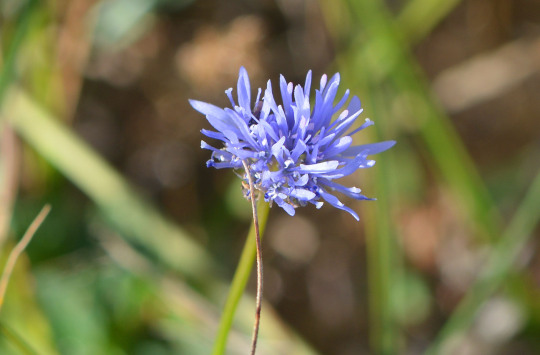

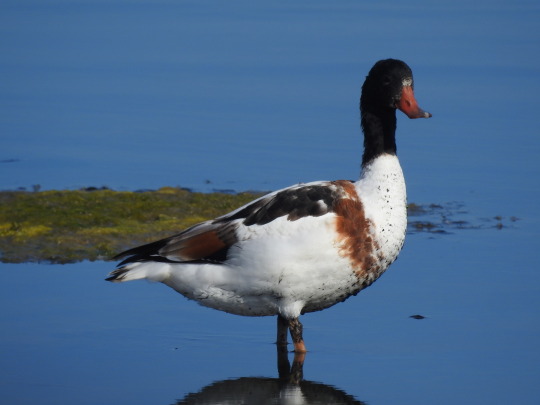

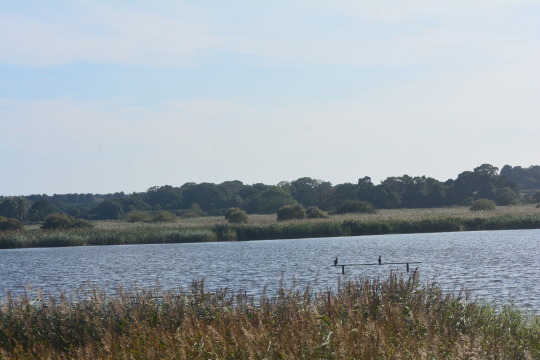
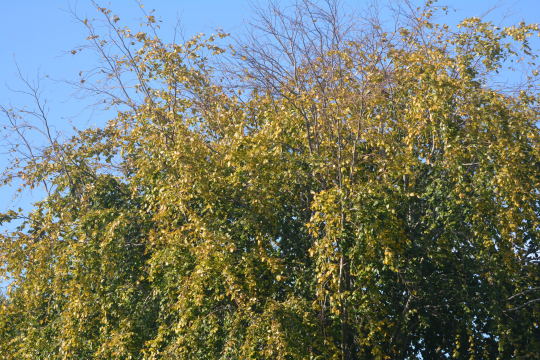
25/09/2023-RSPB Minsmere
Photos taken in this set are of: 1. One of a few Common Sandpipers I relished seeing today, with Green Sandpiper seen well too, some of my greatest ever views of the rustic and cheery Common Sandpiper. 2, 4, 8 and 9. Beautiful views, it really is such a vast, precious and wild mixture of habitats; endless reedbeds, glistening scrape, sea, rich woodland, grassland, views of heath and strong vistas all around. It was so invigorating to be out here so long today to begin the weekdays of my week off, the relaxing that weeks off are all about for me. 3. A Small Copper I really enjoyed seeing at the visitor centre. 5. Some glorious sheep's bit which I was thrilled to find at the coast. 6. Grey Squirrel at the visitor centre at the end. 7. A sumptuous Shelduck, seeing these as well as the key bird for this site Avocet crucial to its founding as the RSPB's first reserve what a key moment in nature conservation when it was founded in (the latter especially) great numbers was really heartfelt and calming today two very important species for my interest being some of the first birds I saw at Titchfield Haven as I was just getting into birdwatching as a kid. 10. One of a few great trees observed today in the sunlight that is turning seasonally yellow.
Also standing out of the so much seen here today was the key moment with the main bird we wanted to try and see here with phenomenal flying views of my first Bittern of the year. It is so sweet and satisfying that this idea paid off to allow us to see this quintessential reedbed, enigmatic and awesome species for another year which I feel so lucky to have. Other highlights were Great White and Little Egret, Marsh Harrier and Little Stint which I was pleased to spot. Common Scoters flying over the sea, finely coloured Wigeon, Teal, Shoveler, Black-tailed Godwits, another Ruff of late and great Snipe views were good to see too. Comma, Emerald Damselfly, Southern and Migrant Hawker and Common Darter were other insect highlights. Other highlights were Cormorant, Common Tern, Stonechat, Blue Tit, Red Deers, Muntjac, amazing Water Vole views at the pond at the end in the evening sun what a year I've had for this mammal, Rabbit, Grass snake possibly the first I've ever seen near the Water Vole, cricket, spider, restharrow, my first ever marsh mallow, red campion and tansy with Cetti’s Warbler heard. Ox tongue, water mint, scarlet pimpernel, stork's-bill, gorse, broom, honeysuckle, bramble flower, hawthorn, plums, chestnuts and a few mushrooms were nice to see too. At the hotel we stayed in last night holly, ivy, rose hips and Common Darter were nice to see especially in the sun as well as wasp. Red-legged Partridge in Norfolk on a hay bale and Buzzards in the air were good birds I saw on the journey yesterday with snails enjoyed at home tonight. A decade on from our two previous visits, I cherished amazing time at Minsmere today with an extraordinary list of things seen combining a bit of everything I love seeing and photographing it seems and with an extraordinary list of sightings for birds and mammals especially with many things I'd not often or ever seen on the same day before. What a marvelous nature reserve.
#photography#muntjac deer#bittern#water vole#shelduck#avocet#common sandpiper#small copper#sheep's-bit#rspb minsmere#suffolk#england#uk#earth#nature#september#weekend#birdwatching#butterflies#europe#wildlife photography#landscapes#outdoors#2023
4 notes
·
View notes
Text
Alrighty and HERE ARE OUR CONTENDERS!!!
Tag for the polls: #bird battle
DISCLAIMER - I wrote the round one blurbs when I was very sick and half awake, so if you see any mistakes PLEASE TELL ME! Nicely, obviously, but I want to make sure they sound good for round 2. Thank you!
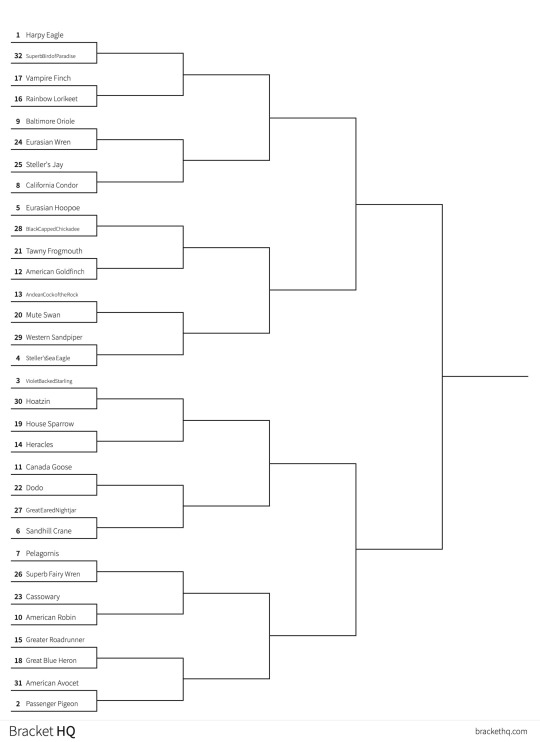

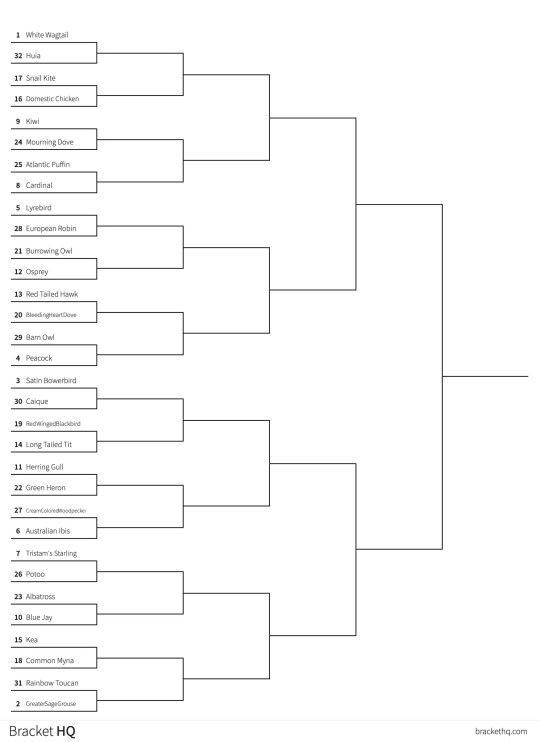

I know there’s a lot of them, but man there’s SO MANY GOOD BIRDS! There were a few times where people didn’t put what specific subspecies for some birds, so sometimes I’d have to choose one. I tried to choose one that represents that bird the best!
I don’t know when the polls will begin, I’m doing some research on the birds so that people can read about them before they vote.
If one of your favs didn’t make it in, don’t worry they’re a winner in my and your heart.
If you are wondering where the Pigeon (Rock Dove) is, THEY ARE THE FINAL CHAMPION! At the end of this bracket, the winner will face off against the mightily popular Rock Dove! Will they be able to beat such a tough challenger? We will see…
Also, a note on how I set this bracket up: I put all the birds in a numbered list and then used a number generator. I think the matchups we got were really interesting.
Full list under the cut
HARPY EAGLE
SUPERB BIRD OF PARADISE
VAMPIRE FINCH
RAINBOW LORIKEET
BALTIMORE ORIOLE
EURASIAN WREN
STELLER'S JAY
CALIFORNIA CONDOR
EURASIAN HOOPOE
BLACK CAPPED CHICKADEE
TAWNY FROGMOUTH
AMERICAN GOLDFINCH
ANDEAN COCK OF THE ROCK
MUTE SWAN
WESTERN SANDPIPER
STELLER'S SEA EAGLE
VIOLET BACKED STARLING
HOATZIN
HOUSE SPARROW
HERACLES
CANADIAN GOOSE
DODO
GREAT EARED NIGHTJAR
SANDHILL CRANE
PELAGORNIS
SUPERB FAIRY WREN
SOUTHERN CASSOWARY
AMERICAN ROBIN
GREATER ROADRUNNER
GREAT BLUE HERON
AMERICAN AVOCET
PASSENGER PIGEON
WALLCREEPER
GREAT TIT
MOA
EASTERN BLUEBIRD
AUSTRALIAN BUSHTURKEY
EMU
MALLARD DUCK
FLAME BOWERBIRD
MANDARIN DUCK
BELTED KINGFISHER
OILBIRD
FAIRY PENGUIN
LESSER FLAMINGO
AUSTRALIAN KESTREL
CARRION CROW
UMBRELLABIRD
LOGGERHEAD SHRIKE
PERUVIAN PELICAN
CALIFORNIA QUAIL
MACGREGORS BOWERBIRD
HARRIS HAWK
COMMON RAVEN
BEARDED VULTURE
PEREGRINE FALCON
ROSY LOVEBIRD
ROSEATTE SPOONBILL
LONG TAILED GRACKLE
AMERICAN WOODCOCK
KAKAPO
BLUE FOOTED BOOBY
RHEA
BEE HUMMINGBIRD
WHITE WAGTAIL
HUIA
SNAIL KITE
DOMESTIC CHICKEN
KIWI
MOURNING DOVE
ATLANTIC PUFFIN
CARDINAL
LYREBIRD
EUROPEAN ROBIN
BURROWING OWL
OSPREY
RED TAILED HAWK
BLEEDING HEART DOVE
BARN OWL
PEACOCK
SATIN BOWERBIRD
CAIQUE
RED WINGED BLACKBIRD
LONG TAILED TIT
HERRING GULL
GREEN HERON
CREAM COLORED WOODPECKER
AUSTRALIAN IBIS
TRISTAM'S STARLING
POTOO
WANDERING ALBATROSS
BLUE JAY
KEA
COMMON MYNA
RAINBOW TOUCAN
GREATER SAGE GROUSE
TURKEY VULTURE
TUFTED TITMOUSE
CRESTED AUKLET
EURASIAN MAGPIE
BUDGIE
SCREECH OWL
WIP-POOR-WILL
SECRETARY BIRD
AUSTRALIAN MAGPIE
CEDAR WAXWING
VICTORIA CROWNED PIGEON
HERMIT THRUSH
COMMON SWIFT
WHITE BELLBIRD
BROWN SKUA
EUROPEAN DIPPER
112 notes
·
View notes
Text
What's the Bird?
Location: UK, England
Date: Winter
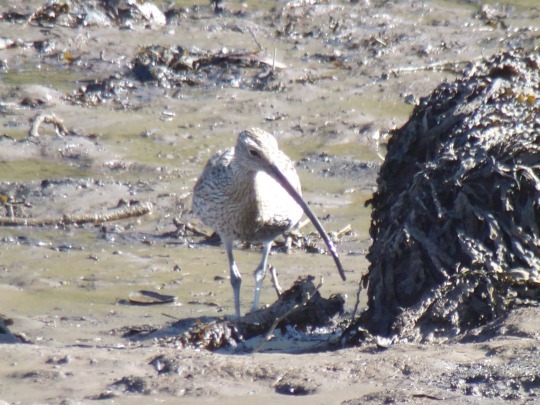
We ask that discussion under questions be limited to how you came to your conclusion, not what your conclusion was.
Happy Birding!
Keep the game alive! Submit a bird HERE
Bird-116 graciously submitted by @inkkyte
17 notes
·
View notes
Text
Bird names that also make good people names: a list
Feel free to use the names in this list for yourselves, for your OCs, for whatever you want!
Anhinga
Ani
Apalis
Aracari
Astrapia
Avocet
Barbet
Reedling
Bittern
Brambling
Canary
Condor
Cotinga
Coua
Crow
Dacnis
Darter
Dove
Dovekie
Dunlin
Egret
Eider
Elaenia
Emu
Falcon
Finch (that's me!)
Francolin
Fulmar
Galah
Goshawk
Grandala
Harrier
Hawk
Heron
Hobby
Hoopoe
Iora
Jabiru
Jacana
Jackdaw
Jaegar
Jay
Junco
Kea
Kestrel
Kinglet
Kite
Kittiwake
Kiwi
Lark
Lory
Macaw
Magpie
Mallard
Manakin
Martin
Merlin
Monal
Murre
Myna
Nene
Nighthawk
Nightingale
Oriole
Osprey
Ostrich
Owl
Parotia
Parula
Petrel
Phoebe
Pigeon
Piper (as in "sandpiper")
Pipit
Pitta
Plover
Prinia
Quail
Quelea
Quetzal
Rail
Raven
Reedling
Rhea
Robin
Roller
Rook
Rosefinch
Rosella
Sanderling
Seriema
Serin
Shrike
Siskin
Sitella
Skua
Skylark
Sora
Sparrow
Starling
Swift
Tanager
Teal
Tern
Tinamou
Tityra
Thrush
Tody
Trogon
Troupial
Tui
Turaco
Vanga
Veery
Verdin
Vireo
Weaver
Whimbrel
Wigeon
Wren
4 notes
·
View notes
Text
woe, wader birds be upon ye






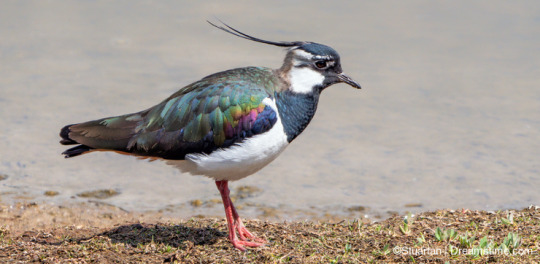
[image ID: photos of wader birds. in order: pied avocet, collared pratincole, painted snipe, red-necked phalarope, spoon-billed sandpiper, ruff and northern lapwing. end ID] credits: x | x | x | x | x | x | x
27 notes
·
View notes
Note
Do yu know what other animals were in ancient egypt? I want my oc to have a unique animal and you seem to know a fair amount

I am a well of ridiculous, hyperspecific, only interesting to some trivia lmao.
I would encourage you not to limit yourself to an entirely unique beast- many deities share sacred animals and are still strong individuals. My mind immediately goes to the huge number of feline deities- lions and lionesses in particular- for an example. Additionally, it's nigh impossible for me (with no academic anthropology/egyptology/historic zoology knowledge) to say for certain that particular animals were present in Kemet when they have no documented deities, mummies, or written mentions. I've had to guess for some, deduce by their present day habitats and more or less "timeline" of their species.
It's also important to keep in mind Kemet had contact with other civilizations in other habitats, meaning they were aware of animals not necessarily native to the area. A perfect example is the Hamadryas baboon- they were Nubian animals, but were sacred to both Thoth and Babi, depicted in art, and many mummies of the species have been recovered. A more surprising example is the Syrian brown bear, which was a rare exotic spectacle for the royal elite. There's also the trouble of many species now being extant from the area, meaning they were there but the local population is now extinct- the African sacred ibis is the example my mind comes to first, the waterfowl no longer present along the Nile.
Coincidentally, I've been compiling a list of animals for my own reference to supply a beast or two for the deities that don't have one in tradition.

Birds
Abdim's Stork
African Darter
African Dwarf Kingfisher
African Grass Owl
African Open-billed Stork
African Pied Wagtail
African Sacred Ibis
Asian Green Bee-Eater
Barbary Falcon
Barbary Partridge
Barn Owl
Barn Swallow
Bearded Vulture
Bennu Heron (likely not an actual animal, the Bennu bird inspired by the Goliath Heron- but felt like including it anyhow)
Black Kite
Black Stork
Black-throated Loon
Black-winged Kite
Brown-necked Raven
Carrion Crow
Cattle Egret
Chukar Partridge
Common Buzzard
Common Cormorant
Common Crane
Common Greenshank
Common House Martin
Common Kestrel
Common Kingfisher
Common Pochard
Common Quail
Common Raven
Common Redshank
Common Redstart
Common Sandpiper
Common Spoonbill
Common Teal
Crab Plover
Crested Plover
Dalmatian Pelican
Demoiselle Crane
Eagle (I'm sure there were some, but I can't find any definitive evidence of species in the ancient Kemetic culture- I would take a guess that the Golden Eage was an infrequent visitor)
Egyptian Plover
Egyptian Vulture
European Roller (considered a pest)
European Turtle-dove
Eurasian Coot
Eurasian Crag Martin
Eurasian Teal
Eurasian Wigeon
Fan-tailed Raven
Ferruginous Duck
Gadwall
Garganey
Glossy Ibis
Golden Oriole
Goliath Heron
Great Bittern
Great Bustard
Great Cormorant
Great Egret
Great Spotted Cuckoo
Great White Pelican
Greater Flamingo (possibly not native)
Green Sandpiper
Grey Heron
Griffon Vulture
Helmeted Guineafowl (not native)
Hermit Ibis
Hobby Falcon
Honey Buzzard
Hooded Crow
Hoopoe
Houbara Bustard
House Crow
House Sparrow (pest, hieroglyph had negative connotation)
Kittliz's Plover
Lanner Falcon
Lappet-faced Vulture
Laughing Dove
Lesser Kestrel
Lesser Pied Kingfisher
Little Bittern
Little Bustard
Little Egret
Little Owl
Long-eared Owl
Long-legged Buzzard
Mallard
Marabou Stork
Marsh Sandpiper
Masked Shrike
Merlin
Mourning Wheatear
Northern Lapwing
Northern Pintail
Northern Shoveler
Ostrich
Pale Crag Martin
Peregrine Falcon
Pied Avocet
Pink-backed Pelican
Purple Gallinule
Purple Heron
Red Kite
Red-backed Shrike
Red-footed Falcon
Red-rumped Wheatear
Reed Cormorant
Ring-necked Dove
Rock Dove
Rook
Ruddy Shelduck
Saddle-bill Stork
Saker Falcon
Sandhill Crane
Sand Martin
Sand Partridge
Short-eared Owl
Spotted Redshank
Sooty Falcon
Squacco Heron
Striated Heron
Swan (not native)
Tawny Owl
Tufted Duck
Western Reef Heron
White-backed Night Heron
White-crowned Wheatear
White Stork
White Wagtail
Wood Sandpiper
Yellow-billed Stork
Mammals
Aardvark (possibly not native)
Aardwolf
Addax Antelope
African Clawless Otter
African Giant Shrew
African Green Monkey (not native)
African Grass Rat
African Leopard
African Striped Weasel
Arabian Oryx
Barbary Deer (not native)
Barbary Lion (now extinct)
Barbary Macaque (not native)
Black Rat
Common Patas Monkey (not native)
Black Rhinoceros
Blanford's Fox
Black Wildebeest
Bubal Hartebeest (now extinct)
Cairo Spiny Mouse
Cape Hare
Caracal
Cheetah
Common Beisa Oryx
Common Genet
Desert Hedgehog
Desert Long-eared Bat
Dorcas Gazelle
Desert Black Cobra
Egyptian Fruit Bat
Egyptian Jackal/African Wolf (originally misidentified, now the African Wolf)
Egyptian Mongoose
Egyptian Pipistrelle
Egyptian Red Fox
Egyptian Slit-faced Bat
Egyptian Tomb Bat
Egyptian Weasel
Egyptian Wild Ass
Fennec Fox
Flower's Shrew
Four-toed Jerboa
Geoffroy's Horseshoe Bat
Gerenuk
Giraffe
Golden Spiny Mouse
Greater Egyptian Jerboa
Greater Mouse-tailed Bat
Greater Red Musk Shrew
Hamadryas Baboon (not native)
Hippopotamus
Honey Badger
House Mouse
Lesser Egyptian Jerboa
Lesser Mouse-tailed Bat
Long-eared Hedgehog
Long-nosed Shrew
North African/Bush Elephant (vilified and driven out by prehistoric Egyptians)
North African Crested Porcupine (not native)
Nubian Ibex (not native)
Olive Baboon (likely not native, sometimes called the Anubis Baboon)
Persian Fallow Deer (not native)
Rhim Gazelle
Rüppell's Fox
Sand Rat
Serval (likely not native, but Ra was depicted as one)
Scimitar Oryx
Soemmerring's Gazelle
Somali Dwarf Shrew
Spotted Hyena
Spotted-necked Otter
Striped Hyena
Syrian Brown Bear (not native)
Wild Boar
White Rhinoceros
Yellow Baboon (not native, species' epithet means 'dog-head' in Greek)
Vervet Monkey
Reptiles
African Chameleon
African Rock Python
Arabian Horned Viper
Desert Horned Viper
Desert Monitor Lizard
Egyptian Cobra
Egyptian Gecko
Egyptian Sand Boa
Egyptian Sand Racer
Egyptian Tortoise
Javelin Sand Boa
Insects/Arachnids/Etc.
Nile Crocodile
Nile Soft-shelled Turtle
Red Spitting Cobra
Saharan Sand Viper
Amphibians
African Common Toad
European Green Toad
Marsh Frog
Mascarene Grass Frog
Nile Delta Toad
Nile Valley Toad
Camel Spider
Banded Garden Spider
Brown Widow Spider
Carpenter Ant
Centipede
Click Beetle
Common Housefly (NOT considered a pest, actually revered as a protector)
Danaid Eggfly
Desert Ant
Desert Locust
Devil's Coach Horse Beetle
Dorippus Tiger Butterfly
Dragonfly
Flea
Fire Ant
Jewel Beetle
Gaudy Commodore Butterfly
Half-edged Wall Jumping Spider
Large Salmon Arab Butterfly
Maggot/Carrion Fly
Migratory Locust
Messor Ant
Millipede
Red-breasted Goose
Mosquito (pest)
Moths in the Saturniidae family
Palestine Yellow Scorpion
Pantropical Jumping Spider
Pharaoh Ant
Plain Tiger Butterfly
Praying Mantis
Scarab Beetle
Sinai Baton Blue Butterfly
Southern White Admiral Butterfly
Scorpions in the Buthidae and Scorpionidae families
Water Scorpion
Fish, Mollusks, etc. (Keep in mind fish were taboo in Kemet)
Abju
African Catfish
African Tigerfish
Bayad Fish
Blacktip Shark
Blue-spotted Stingray
Bolti
Chromis
Cichlid
Cornish Jack
Eel
Flatfish
Gilt-head Bream
Great Barracuda
Leopard Shark
Lepidotus Fish
Loligo Squid
Lungfish
Moon Fish
Mullet
Nile Barb
Nile Bichir
Nile Carp
Nile Mormyrid
Nile Labeo
Nile Perch
Nile Puffer
Parrotfish
Reef Manta Ray
Reef Shark
Sandbar Shark
Sea Snake
Scorpionfish
Spiny Lobster
Sturgeon
Surgeonfish
Swordfish
Thornback Ray
Thresher Shark
Tiger Shark
Tilapia
Triggerfish
Unicorn Fish
Wrasse
Zebra Shark
Domestic Animals
Bean Goose
Brant Goose
Camel (not introduced until Middle/New Kingdom)
Cats (Mau breed)
Chickens (not introduced until New Kingdom era)
Cow/Bull
Dogs (Saluki, Greyhound, Basenji, and Pharaoh Hound breeds)
Donkey
Egyptian Goose
Greater White-fronted Goose
Greylag Goose
Honey Bees
Horse (not introduced until New Kingdom)
Pig
Ram
My sources, if you're interested, are the Wikipedia page for Egyptian wildlife, a few different diving sites about the Mediterranean and Red Sea, a couple books I own on Ancient Egypt that describe the geography of the periods, and this lovely reddit multi-post
Sheep
13 notes
·
View notes
Text
Let's kick off the 🐉Wings of Fire aus' names lists with...
The 🛖MudWings🐊!
The X-Men Members:
• Charles Xavier/Professor Xavier: Cypress
• Ororo Munroe/Storm: Morass
• Logan Howlett/Wolverine: Loam
• Scott Summers/Cyclops: Sedge
• Jean Grey/Marvel Girl/Phoenix: Grebe
• Hank McCoy/Beast: Heron
• Anne-Marie/Rogue: Mallow
• Remy LeBeau/Gambit: Rush
• Kitty Pryde/Shadowcat: Sandpiper
• Kurt Wagner/Nightcrawler: Kobicha
• Jubilation Lee/Jubilee: Juncus
• Evan Daniels/Spyke: Snipe
• Bobby Drake/Iceman: Bronze
• Piotr Rasputin/Colossus: Python
• Illyana Rasputin/Magik: Ibis
• Rahne Sinclair/Wolfsbane: Fen
• Samuel "Sam" Guthrie/Cannonball: Salamander
• Roberto da Costa/Sunspot: Copper
• Danielle "Dani" Moonstar/Mirage: Moor
• Laura Kinney/Wolverine 2.0: Lilypad
• Tabitha "Tabby" Smith/Boom-Boom: Terracotta
The Brotherhood:
• Erik Lehnsherr/Magnus/Magneto: Mire
• Raven Darkholme/Raven: Russet
• Victor Creed/Sabretooth: Copperhead
• Pietro Maximoff/Quicksilver: Peat
• Wanda Maximoff/Scarlet Witch: Widgeon
• Mortymer Tonybee/Todd Tolansky/Toad: Toad
• Fred "Freddy" Dukes/Blob: Fen
• Lance Alvers/Avalanche: Avocet
• St. John Allerdyce/Pyro: Possum
Yes. I'm going to match names to all of these characters, for each tribe. But here's a treat...
• Reader/Bby: Alligator, Cashmere, Lotus, Slough, Tadpole, Caiman, Moss...
#honeycomb thoughts#platonic yandere marvel#yandere platonic marvel#platonic yandere marvel x reader#platonic yandere xmen#yandere x-men#platonic yandere#platonic yandere x reader#🐉Wings of Fire AU#🛖MudWing🐊 AU
5 notes
·
View notes
Text
birds
A few more bird updates! Campanile falcons, birdwatching this morning, and a reply about a previous birdwatching outing.
The Campanile peregrine falcons fledged today! The female, named Lindsay [after the wildlife rehabilitation facility that treated Grinnell when he was injured in the autumn], went first, which is unusual, but I suspect she was the one who hatched first. She hopped down to the “fledge ledge” a little before 6am, and took her first flight before any of the Fledge Watch volunteers had arrived. When they got there, they spotted her on top of one of the campus libraries. Yay! And then this evening her little brother Grinnell Jr. jumped out and flew a little loop back to the nest level at the Campanile, and then a minute later he took a longer flight and landed in a tree.
This morning, I went birdwatching with a friend, but we didn’t make it to the salt marsh. Instead, we went to some mudflats when the tide was starting to come in after a very low tide. We saw lots of birds, including some I hadn’t really managed to identify before and also several “high-quality” birds:
4 American avocets
at least one whimbrel
lots and lots of marbled godwits (I reported 60), though some were far away and could have been whimbrels or curlews or dowitchers or something else.
at least 60 brown pelicans, some juvenile or immature [@lies, is there a technical difference between juvenile and immature? I feel like there probably is.]--they are ridiculous creatures.
2 great blue herons being tall and dorky
1 great egret, flying
at least 30 snowy egrets
3 black-crowned night herons! which is more than I usually see in one outing
a barn swallow
a bunch of (20?) cliff swallows
at least 3 northern rough-winged swallows, we think based on Merlin’s sound ID and the fact that some of the swallows didn’t have the coloration of the cliff swallow.
I was especially pleased about the swallows, which I normally struggle to identify--having someone else with me who is more familiar with swallows helped, and also there were enough of them swooping pretty nearby that we were able to get a good look. The cliff swallows and northern rough-winged swallows were new to my eBird life list.
A reply about a previous birdwatching outing:
lies said: I’ve usually seen “peep sp.” used to lump together Calidris shorebirds like western sandpiper and least sandpiper. From your report a fledgling black-necked stilt sounds like a good guess. Did it look like the young bird in this beautiful photo by Dorian Anderson? macaulaylibrary.org/ass…
What a great photo! Yes, that does look like what I saw, as far as I remember. Very cute! Should I edit the list to say it was a black-necked stilt baby?
11 notes
·
View notes
Note
hello o !! so excited to see the blog !! it looks so cool !!
can i just have a compilation of bird names. like literal bird names. not themed around them just birds obviously theres so many but as many as you’re comfortable with would be great :-D
- wren ! !
Thank you for the request! You're actually the first request. Originally I had a bunch typed out but Tumblr glitched so I have to do this three times and I kinda lost some of the motivation after the second, sorry
This is listed in two different ways, since some people think the second is easier to read!
Passerine, Albratross (Alba), Sandpiper (Piper), Falcon (Falco), Columbidae, Crow, Corvid, Parrot, Gull, Owl, Duck, Cormorant, Cuckoo, Swift, Stork, King(fisher), Crane, Woodpecker (Woody), Sparrow, Heron, Nightjar, Tyrant (flycatcher), Songbird, Skuas (Sky), Stilt, Avocet, Swallow, Starling, Anhinga, Quail, Dove, Sulid, Cardinal, Cassowary (Cassie), Ostrich, Emu, Auklet, Bittern, Chickadee, Cowbird, Dowitcher, Eagle, Finch, Goldeneye, Goose, Gull, Hawk, Ibis, Jaeger, Jay, Junco, Jay, Kingbird, Kinglet, Kite, Loon, Magpie, Murrelet, Petrel, Phoebe, Pipit, Puffin, Raven, Redstart, Scoter (Scooter), Shrike, Tern, Thrasher, Vireo, Vulture, Warbler
Second way of reading
Passerine,
Albratross (Alba)
Sandpiper (Piper)
Falcon (Falco)
Columbidae
Crow
Corvid
Parrot
Gull
Owl
Duck
Cormorant
Cuckoo
Swift
Stork
King(fisher)
Crane
Woodpecker (Woody)
Sparrow
Heron
Nightjar
Tyrant (flycatcher)
Songbird
Skuas (Sky)
Stilt
Avocet
Swallow
Starling
Anhinga
Quail
Dove
Sulid
Cardinal
Cassowary (Cassie)
Ostrich
Emu
Auklet
Bittern
Chickadee
Cowbird
Dowitcher
Eagle
Finch
Goldeneye
Goose
Gull
Hawk
Ibis
Jaeger
Jay
Junco
Kingbird
Kinglet
Kite
Loon
Magpie
Murrelet
Petrel
Phoebe
Pipit
Puffin
Raven
Redstart
Scoter (Scooter)
Shrike
Tern
Thrasher
Vireo
Vulture
Warbler
#i have the worst cold rn ughhhh#💌; names.txt#name suggestions#💌; asks.txt#name#names#name ideas#baby names#bird#birds#bird names
2 notes
·
View notes
Text



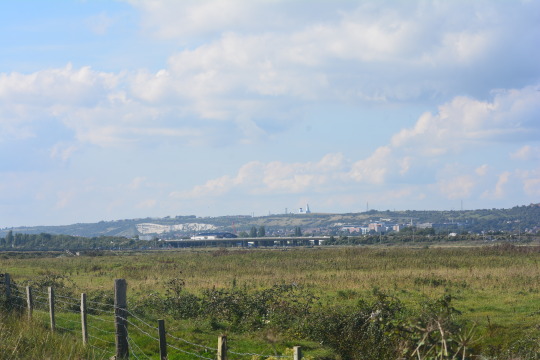
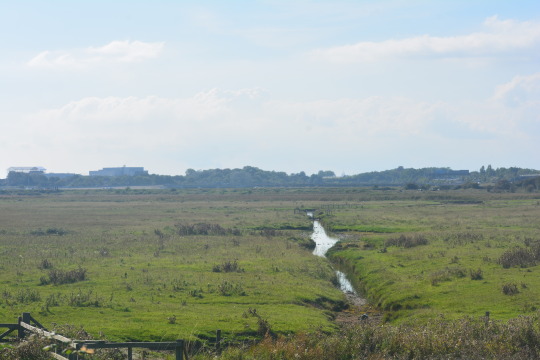
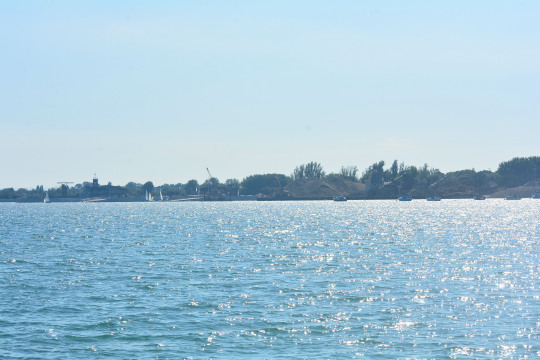
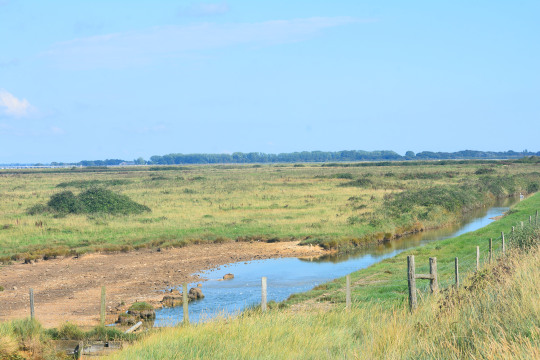


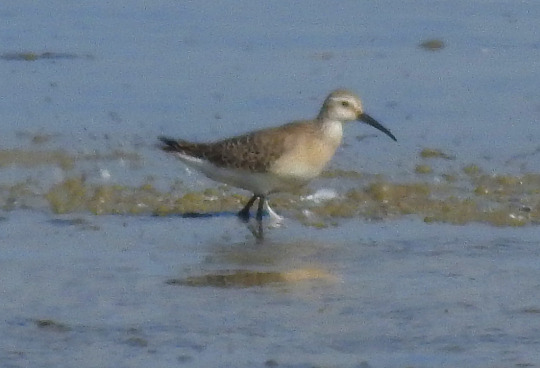
2/9/23-Fantastic wild afternoon at Farlington Marshes
Photos taken in this set are of: 1. Grey Plovers which I was thrilled to see making the most of some in summer plumage, a fine wader. 2. A Kestrel with prey, it was delightful to watch it hunt by hovering over the grass too before seeing it catch prey and eat it on the post/in grass. 3-7. Views on a stunning sunny afternoon, the blue sky and sea so nice to drink in. 8. Yellow Wagtail, I am euphoric to have seen a few of these at the feet of cattle. A bird I am very fond of and these were my first of the year after a month or so of trying to see them. It was very rewarding to see these, a key late summer/autumn bird that it's a pleasure to see again this year. Such prepossessing birds one was really bright yellow. 9. Rock samphire which was pretty to see. 10. A smart looking Curlew Sandpiper, it was good to see a couple of these on the lake a key bird here at this time of year another I love which it was a pleasure to see for a second time this year after one at Pennington in the spring.
A bird I often see at the same time as and associate with Curlew Sandpiper, Little Stint was another bird we came here to look for today having heard it was here and we saw it on the lake. A splendid and petite wader and another big bird for my year taking my year list to 216. It was an epic afternoon's birdwatching with a strong variety of species and some amazing ones, in the midst of autumn migration combining a few species I'd not seen on the same day before. Other highlights were a second Osprey this week for me on distant bare trees they like in Langstone Harbour which is amazing what a year I'm having for them, thrillingly a more common sight here these days Cattle Egrets, Grey Heron, Greenshank, Common Sandpiper, Black-tailed Godwits with one in strong plumage, Avocet, Lapwing, Oystercatcher, Ringed Plover, Shelduck, Teals and a Coot seen flying I'm not sure I'd seen one fly before. A lovely view of a Redstart right at the end, we don't often see these (passing through) birds here but it is the first place we ever saw one in our early birding days so this was nice, Wheatear (it feels like yesterday we saw our first of the year here in spring now they're on their way back out), Goldfinch, Starlings, Rabbits and exquisite views of Swallows and Sand Martin against the blue sky were also great to see. For butterflies on a perfect late summer day for them Meadow Brown, pretty Small Heath and Small White were ones I saw well with top views of Migrant Hawker dragonflies too. My first Michaelmas daisy or sea aster at a distance this year, silverweed cinquefoil, chamomile, ragwort, fleabane, bird vetch, bird's-foot trefoil, nightshade, dock, teasel seed heads, blackberries, elderberries and hawthorn were key plants seen. It was great to hear Cetti's Warbler.
#photography#curlew sandpiper#yellow wagtail#little stint#osprey#cattle egret#wheatear#redstart#grey plover#avocet#common sandpiper#lapwing#oystercatcher#greenshank#uk#world#nature#earth#farlington marshes#farlington#portsmouth#happy#birdwatching#england#europe#2023#september
0 notes
Text
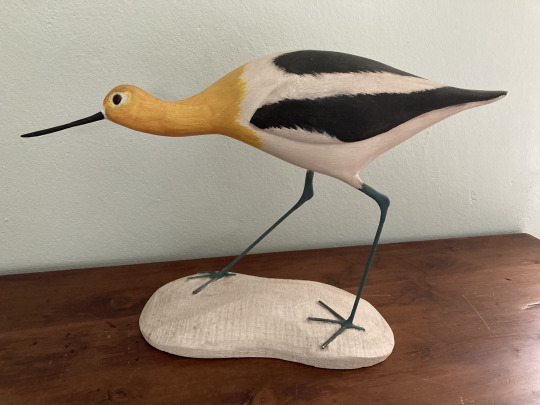
Won another wooden carved bird in my mother-in-law's annual charity auction. He will join the pair of sandpipers (Sandy and Piper) and the Marshpiper (Marshall).
He's an Avocet but I misread it as "Advocate" so now his name will forever be The Advocate.
1 note
·
View note
Text
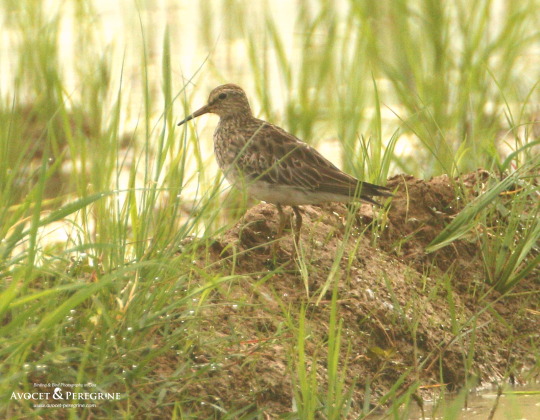
another rare bird for Goa in this streak of 15 days
Pectoral Sandpiper
Curtorim Wetlands
6th January 2023
clicked on an Avocet & Peregrine trip!
Visit the website: https://birding.avocet-peregrine.com/
0 notes
Text
Deep in Florida, an ‘Ecological Disaster’ Has Been Reversed—and Wildlife is Thriving
Much of Florida’s Kissimmee River has been restored to its natural state, a milestone worth celebrating—and learning from.
— Photographs By Carlton Ward Jr. | April 6, 2023

The Kissimmee’s meandering floodplains teemed with life before they were diverted into a straight canal a half century ago. A recently completed project has restored the curves—seen here—and replenished the wetlands. The waterfowl, raptors, fish, and mammals are returning. By Douglas Main
If you’ve been to Disney World in Orlando, you’ve been to the Northern Everglades. Much of the water within the famous “river of grass” originates in Central Florida and flows south via the Kissimmee River—one of the more important and lesser-known waterways nationwide.
Sixty years ago, the Kissimmee meandered for more than 100 miles from the Kissimmee Chain of Lakes to Lake Okeechobee, and its floodplains were home to seasonal wetlands rich with life. But in the 1940s, in response to flooding and hurricanes, the state asked the federal government to help build a sprawling network of canals and waterways to drain the land.
The Army Corps of Engineers complied and, beginning in the 1960s, turned the meandering Kissimmee into a 30-foot-deep, channelized canal. Within a few years, populations of waterfowl dropped by 90 percent, bald eagle numbers by 70 percent, and some fish, bird, and mammal species vanished. The channel acted like a pipe, moving water quickly off the landscape to Lake Okeechobee, and then to the ocean. While that helped prevent some flooding in the short term, it robbed the stream of oxygen, which decimated the fish community and gave nutrient pollution no time to settle and be absorbed by the wetlands.
The disrupted hydrology and ecological problems were so glaring that, beginning in the 1990s, the Army Corps and a variety of state, federal, and local partners cooperated to undo the damage. More than 20 years later, at a cost of over $1 billion, the physical restoration of the river is now complete: 40 square miles of wetlands have been reestablished and rehydrated.

Researchers Fabiola Baeza-Tarin (right) and Nicole Rita (left) place bands on Florida grasshopper sparrows, one of the most endangered bird species in North America. These creatures are making a comeback in the prairies surrounding the Kissimmee River.
Already the biological impact of the project has become clear. As the wetlands have come back, so have the birds. “That response was immediate and pretty impressive,” says Lawrence Glenn, director of water resources with the South Florida Water Management District.
‘Triumph of Imagination’
In all, nearly half of the river has been restored to its original state. The project involved filling in 22 miles of the canal, re-carving sections of the old river, and restoring 44 miles of the waterway’s natural meandering paths, according to the Army Corps.
“It's a triumph of imagination [and] of partnership between the federal government and the state” and other organizations coming together, says Shannon Estenoz, assistant secretary for fish and wildlife and parks with the Department of Interior, who formerly worked for several different environmental organizations in Florida.

Populations of popular game fish, such as bass, have climbed, in part because the water is more oxygenated and invertebrates that demand such conditions, such as mayfly and caddisfly larvae, have returned. Populations of wading and waterbirds are already above intended targets; some species that disappeared during the days of the canal—including ibis, bitterns, avocets, and sandpipers—are back.
The restoration is a grand success story that “shows it’s possible to act at the landscape scale, and [it] demonstrates how quickly ecosystems can recover,” Estenoz adds. And it’s vitally important for water quality and the threatened species that live there, including limpkins, snail kites, and bald eagles, says Congressman Darren Soto, whose district abuts the river.
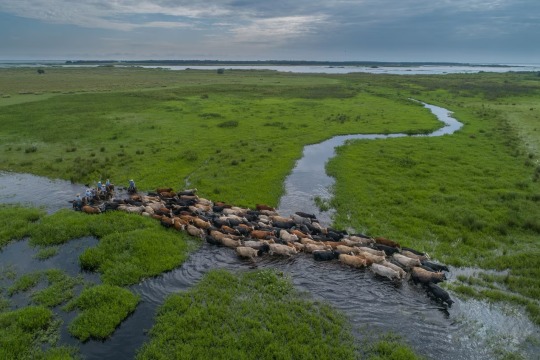
Riders on horseback move cattle across Otter Slough on the Lightsey Ranch with Lake Kissimmee in the background. The Lightsey family has protected more than 90 percent of their land in conservation easements, helping steer development away from sensitive areas in the Everglades Headwaters and Kissimmee River Valley. First receiving cattle and horses from the Spanish in 1521, Florida has the longest history of cattle ranching in the United States.
The Kissimmee will become part of the National Wild and Scenic Rivers System, thanks to an act sponsored by Soto and signed into law as a part of the 2023 Consolidated Appropriations Act. The designation entails special protections and future funding for conservation work.
On the Water
To see the fruits of the restoration myself, I take a late summer ride down the river with photographer and National Geographic Explorer Carlton Ward, Jr., and Adam Bass, vice president of Conservation Florida. The first stretch of the river, directly south of Lake Kissimmee, consists of the old canal—300 feet wide and 30 feet deep, straight as a runway, with almost no birds or wildlife to mention. This part was left as a canal in part to prevent flooding in the Orlando area.
Passing through a lock to get the restored part of the river, the difference is stark and obvious as the river begins its natural flow. The abrupt edges are replaced by thickets and grasses and sabal palms and oaks—and we start seeing birds: herons, egrets, limpkins, and more. Surveys show that there are 50 species of fish in the Kissimmee, nearly 70 species of wetland-dependent birds, over 20 types of reptiles and amphibians, and four mammals that only live in the rehydrated marshes.
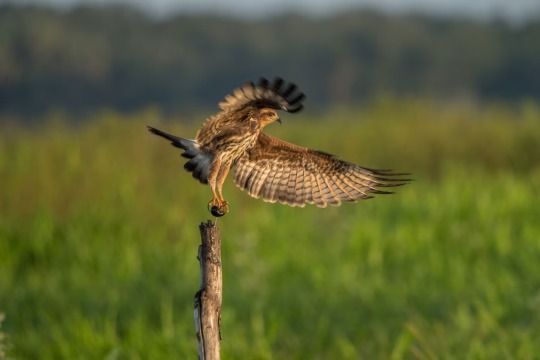
Snail kites are medium-sized hawks that feed on mollusks. They are considered an endangered species in Florida, the northern end of their range. The Kissimmee and its surrounding wetlands are an important habitat for them.
It's the rainy season and the wetlands are flooded, partially submerging vast fields of grasses and flowers. We pass dozens of alligators and bass fishermen. Though we are in crowded South Florida, there are long stretches where we see no people and hear only the sounds of frogs and waterbirds. This is still a wilderness. The river wiggles and bends and sometimes braids, leaving multiple pathways to choose from.
The next morning we wake before dawn and head out. As light creeps over the water nearly 10 snail kites—a subtropical species that’s considered endangered in the United States—fly overhead, many with apple snails in their beaks, large mollusks nearly the size of my fist.
These medium-sized hawks have striking red eyes and hooked beaks; the males are an almost bluish gray, with cream-and-slate undertails, the females a mottled chestnut and white.
Near the town of Lorida, we pull off at the Istokpoga Canal Boat Ramp—one of the only direct ways to access the restored part of the river, and meet Paul Gray, science coordinator with Audubon Florida. He also explains how the restoration project adds 100,000 acre-feet of water storage, which helps prevent flooding, and slows much of the water down, allowing nutrients to settle out.
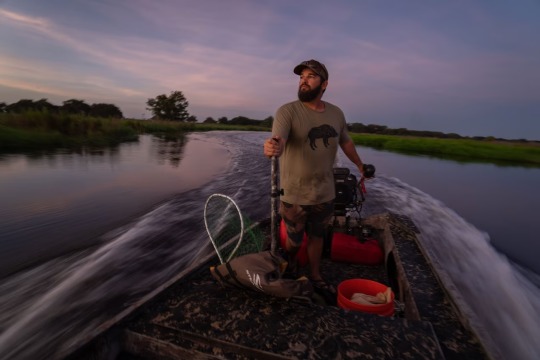
Adam Bass, with Conservation Florida, steers his mud boat through a restored section of the Kissimmee River. With 1,000 people moving to Florida each day and land rapidly being developed, conservationists are working to protect land surrounding the Kissimmee and in the Florida Wildlife Corridor for the benefit of people and wildlife.
One night, we make camp along the river, serenaded by tree frogs and katydids—and watch fireflies flash in an open field, mirrored by twinkles of lightning in a brooding storm cloud on the horizon. Camping in Florida in August is not for the faint of heart, though, as a self-regenerating swarm of mosquitos appears at dusk—the likes of which I’ve never experienced.
Back to the Future
When the channelization was completed in the 1970s, everybody realized it was a mistake. Locals had been against it from the beginning, explains Monrad Chandler, a longtime resident of the area, because “a lot of people used to make a living on the river.”
We’re sitting on a parcel of land he owns right next to the Kissimmee. His son-in-law, Matt Pearce, ranches on this land, where he practices rotational grazing—cattle are currently excluded from this area, allowing the plants to recover and grow back.
“When they channelized the river, there was no marsh no more … then no ducks, no snipe, [no] wading birds,” he says. “A lot of people had to change their livelihood.”
“It was an ecological disaster,” Gray agrees.
But now, those birds are coming back—and the restored section looks essentially the way it used to, Chandler says, fondly recalling hunting and fishing on the river as a youngster.

The Kissimmee River and surrounding wetlands flooded after Hurricane Ian. This helped to prevent property damage in developed areas. “The Northern Everglades’ biggest challenge is water storage,” says Paul Gray, science coordinator with Audubon Florida, and these rehydrated wetlands help take excess water.
These restored wetlands provide corridors for larger wildlife such as Florida panthers and bears and habitat for endangered species, including grasshopper sparrows. By storing water, they also help prevent flooding during storms.
“The Kissimmee River accomplished an amazing feat last summer when Hurricane Ian slammed Florida,” Ward says. “It filled to the 100-year flood level and did its job naturally absorbing billions of gallons of water, with no loss of property, because of the restoration efforts.”
Yet there’s still much work to be done. About half of the Kissimmee consists of a canal, and there’s a big backlog of hydrological and research projects. One vital and imminent project involves raising the water level in Lake Kissimmee—and thus increasing water storage.
Gray explains that various areas of Florida—including Orlando—are running out of easily accessible water, draining the state’s aquifers. “These water projects are going to become more and more important for the future of Florida,” Gray says.
“This project is going to be saving water, going to be slowing it down—not only is that a benefit to wildlife, but to water management, and our ability to meet [our] water needs.”
1 note
·
View note
Text
3 Great Birdwatching Spots in Driving Distance of Dickinson, ND

Going on a birdwatching trip is one of the best activities you can enjoy on a weekend or a holiday. Breathing some fresh air, going for a hike, and finding some of the beautiful species of birds that live in the region is a wonderful way to relax and recharge your batteries. Here are three of the most wonderful birding destinations you can reach in less than one hour by car from downtown Dickinson, ND.
1. Theodore Roosevelt National Park
Providing habitat to golden eagles, great-horned owls, black-capped chickadees, wild turkeys, white-throated sparrows, and sandhill cranes, Theodore Roosevelt National Park is one of the go-to destinations among birders and nature lovers from the region. Getting to this national park takes about 35 minutes by car from the Dickinson city center, driving west along route I-94.
Established in the late 1970s, Theodore Roosevelt National Park has become one of the most popular nature reserves among North Dakota residents, spanning an area of over 70,000 acres and welcoming more than 750,000 visitors each year. Besides birding and wildlife watching, this national park is also a well-known spot for hiking, camping, fishing, and seasonal hunting.
2. Lake Ilo National Wildlife Refuge
Encompassing an area of over 4,000 acres and located about 40 miles north of downtown Dickinson, Lake Ilo National Wildlife Refuge is a great spot for birding and wildlife photography. This nature reserve provides habitat to large populations of sandpipers, American avocets, tree swallows, marsh wrens, black-crowned night herons, savannah sparrows, meadowlarks, and other local and migratory species.
Driving from Dickinson to Lake Ilo National Wildlife Refuge takes just 40 minutes via route ND-22. Although wildlife watching is the most popular activity in this nature reserve, the place is also known for boasting one of the largest assemblages of Paleo-Indian artifacts in the entire country, making it a wonderful destination not only to enjoy some time in nature but also to learn about the precolonial history of the region.
3. Little Missouri National Grassland
Part of the Dakota Prairie Grasslands complex, Little Missouri National Grassland encompasses an area of over one million acres and is home to several different species of birds including prairie falcons, rock wrens, and yellow-breasted chats. This nature reserve is located about 50 miles northwest of Dickinson and can be reached in less than one hour by car via route I-94 and Franks Creek Road.
With its luxurious exterior design, versatile and comfortable cabin, and plenty of room for passengers and cargo, the 2023 Chevrolet Tahoe Premier is a fantastic vehicle to explore these and other nature reserves in North Dakota. Stop by Sax Motor today, take this premium SUV on a test drive, and experience our unmatched customer service.
1 note
·
View note
Text
Big Year Update
It is amazing how fast this year is going! I posted my last blog the first week of August after returning from our second trip to Rainy River. At that time, I had 303 birds on my big year list. Since then I have picked up another 18 birds but it has not been easy.
It started on August 1. We had heard about a Buff-breasted Sandpiper at the Blenheim Sewage Lagoons. Jim and I drove to Blenheim only to hear that the bird had flown off a short time ago and had not been seen since. 3 hours later after most of the others had given up and left, we were making one final pass between the lagoon cells and there sitting on the grass right in front of us was the bird – phew!!
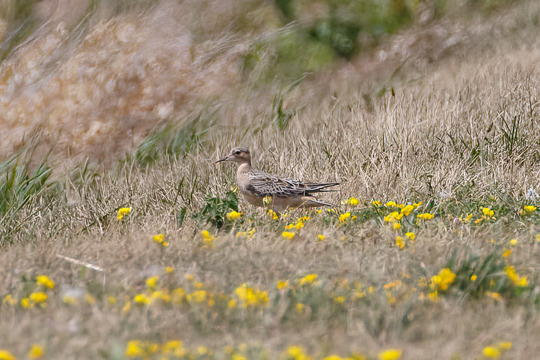
The next day we went to Mitchell and added the Baird’s Sandpiper to the list (at the sewage lagoons of course) and then Jim suggested that we make a run to Kingston to look for the Neotropic Cormorant. I had already tried for this bird in Amherstburg at least three times without luck so I was a little hesitant about making such a long drive. Thankfully, we found the bird since it was an overnight trip and quite expensive for one bird!
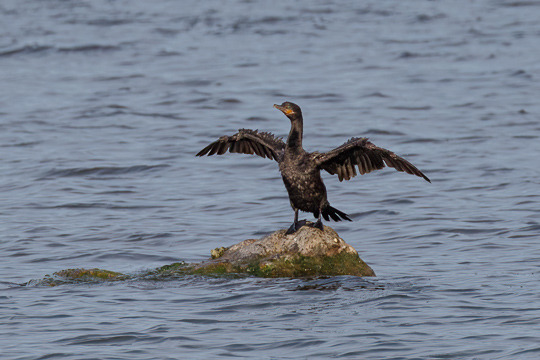
To give you an idea of how much we have travelled just to get 18 birds, we have gone to Van Wagner’s Beach in Hamilton 4 times, Blenheim – 4 times, Hamilton/Burlington area – 3 times, Chatham-Kent – 3 times, Sarnia – 3 times, Point Pelee – 2 times, and the following places at least once: Kingston, Algonquin Park, Barrie, Mitchell, Pelee Island, Manitoulin Island, St. Catharines, Presqui’ile Provincial park, St. Catharines, Toronto, Long Point, Pickering, Bowmanville, Kettle Point, Tilbury and Amherst Island.
The first week of September, we had visitors from Switzerland. We were having a nice lunch on the first day near the Pinery when I received a message that there was an American Avocet at the Blenheim Sewage Lagoons. Barbara was up for it so she and I made the 90 minute drive (each way!) to Blenheim so that I could show her a Canadian sewage lagoon and get a new bird for my list.

The next day, we made a little detour on the way to Algonquin Park to see the Yellow-crowned Night Heron in Toronto. Fortunately Barbara and Bernard were flexible and didn’t mind a little extra time in the car to help me reach my goal.

The last couple of weeks have involved a fair bit of travelling and enduring crappy weather but it has been worth it. I picked up several new life birds and am now sitting at 321 for my 2022 Big Year list.
There are just a few regular migrants left that I hope to pick up by the end of the year so any other additions to the Big Year list will be attributed to rarities that may happen to visit Ontario for a day or two and my ability to get there before the bird flies.
Stay tuned ....
0 notes